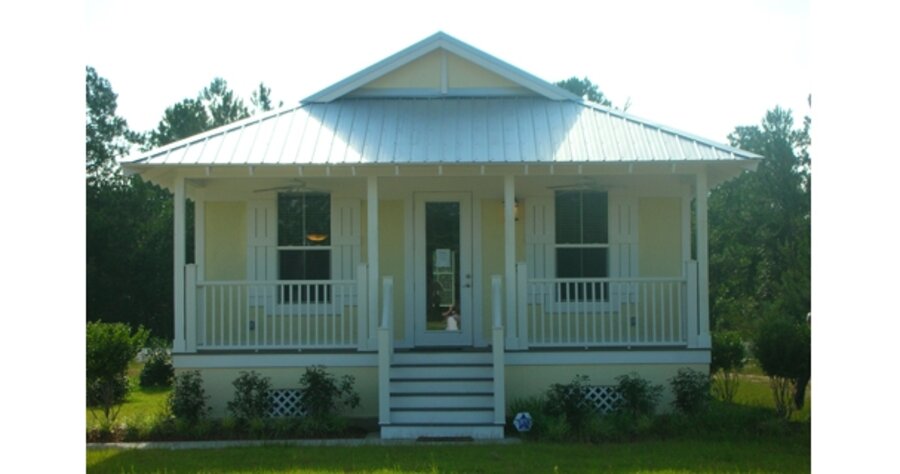Everhouse: A new plan for post-Katrina homes
Loading...
| Charlotte, N.C.
John Sawyer’s vision for the next phase of Katrina recovery revolves around a simple home.
Three years after hurricanes Katrina and Rita battered the Gulf Coast, housing remains a major problem in the region. There’s a shortage of skilled labor to build new homes, insurance rates have skyrocketed, and most federal aid for temporary housing expired this year.
Mr. Sawyer’s response: the Everhouse, a single-family home built from concrete wall panels that are wind-, fire-, mold-, and pest-resistant. About $68 per square foot, the Everhouse is about half the cost of affordable housing in some Gulf Coast cities.
Sawyer is a Boston-based builder who’s used to working on golf-course communities and retirement homes. But when he and his partner, Harold McKenna, visited the Gulf Coast area after the storms, they started brainstorming a housing solution that could improve on the recent “Katrina cottages.”
Step 1: Who will build them?
“We readily saw that there is an acute shortage of skilled construction labor in the area,” says Sawyer. “And when you consider the scope of the problem – 700,000 homes damaged [by the hurricanes] and 250,000 homes destroyed – you realize that you’re going to have to create your own labor force if you’re going to be at all successful.”
But there’s a two-prong problem. Without many local skilled workers, they’d need to both find new people and then train them. So, the duo teamed up with the United Brotherhood of Carpenters and Joiners (UBC), an organization of 500,000 tradespeople and one of the biggest publishers of how-to training manuals.
The carpentry union runs 250 national training centers, says Dan Maples, the brotherhood’s vice president of the Southern District, including one center in Moss Point, Miss., near where Sawyer and Mr. McKenna want to build the first 1,500 Everhouses. There, the trainers will sign up and educate whomever in the area is ready to work. Sawyer’s team will pay the new recruits union wages and the workers have the opportunity to buy and live in the houses once they’re done.
“We hope to create a crew that will become skilled at all the trades necessary for completion of the house,” says Mr. Maples. “Then they can use those skills to build other homes and go on to become a viable workforce for home building and commercial structures in the Gulf Coast area.”
Step 2: How to build?
With deals in place to train a new workforce, Sawyer moved on to planning a timetable for construction.
He wanted to emulate the Scandinavian factory-crafted model, where a united group tackles the whole project instead of the subcontractor method typical in American construction, where individual tasks are outsourced to several distinct groups.
The Scandinavian model brings everyone to the same site, making each stage easier to coordinate and saving time and money, he says.
To keep costs down, the components of an Everhouse are made by a factory in Palatka, Fla., and then delivered to the land where each unit will be built. And like a desk from Ikea, the pieces arrive with all the necessary materials included.
“There’s nothing different between building in the field versus building in a factory,” says Sawyer.
The designs are so simple that workers can assemble the shell of an 1,300-square-foot Everhouse in one day, the team says. The next day, all the windows and doors should be installed and the house can then be secured by lock and key.
After that, Sawyer sees each house being completed in no more than eight days. His goal is to go from start to finish within 400 labor hours.
Step 3: What to build?
Sawyer and McKenna asked architect Steve Mackenzie to design some prototypes that would address the heat and hurricanes that are common to the Gulf Coast area.
They opted for a “panelized” design, because the concrete panels are easy to transport and give both the designer and homeowner a good amount of flexibility in house plans.
“John and I did a [similar project] a few years back,” says Mr. Mackenzie. “The Everhouse is simply the natural outgrowth of our desire to address the many elements in home building – design, construction, permitting, financing, and insurance – in a practical and unique way.”
The current Mississippi model has received kudos from John “Shorty” Sneed, a local insurance broker.
Mr. Sneed thinks the Everhouse is “well-built and built efficiently.” And, as an insurance expert, he likes the idea that it’s designed to stand up against the hurricane-force winds that often buffet this part of the country. “When you consider that this house can save you 25 to 35 percent on insurance costs, it makes a real impact on the affordability issue,” he says.
Sawyer hopes to launch into full production (1,500 Everhouses a year) by the end of fall.
While happy to help Mississippi in this rough time, Sawyer and McKenna are looking to make a profit off the Everhouse. They wouldn’t say how much. But if they’re able to bring both new jobs and new homes, they expect that there will be a lot of new money for everyone involved.





